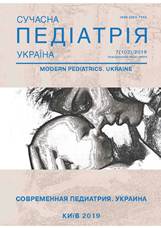The influence of the eventrated viscera injuries on viscero-abdominal disproportion degree in simple gastroschisis
Keywords:
gastroschisis, eventrated viscera injuries, viscero-abdominal disproportion, surgical treatmentAbstract
Eventrated viscera injuries in gastroschisis (GS) lead to postoperative motility disturbance, increase the length of hospital stay and mortality, however, their influence on the degree of viscero-abdominal disproportion (VAD) has not been sufficiently studied.Aim of the study. To investigate the effect of eventrated viscera injuries on the degree of VAD in simple gastroschisis.
Materials and methods. This study enrolled 107 infants with simple GS that underwent surgical management at SI «Institute of Pediatrics, Obstetrics and Gynecology named after academician O. Lukyanova of the National Academy of Medical Sciences of Ukraine (n=84) and Mykolaiv Regional Children's Clinical Hospital (n=23) for the period from 1987 to 2019. Group 1 enrolled the patients without bowel damage (17.8%; n=19). Group 2 included the newborns with moderate bowel injuries (33.6%; n=36). The children from group 3 showed severe affected eventrated viscera (48.6%; n=52).
Results. No significant difference in the incidence of absent and moderate VAD was found (31.5% vs. 68.4%; p=0.12) among the patients without bowel damage. A severe VAD was not diagnosed among the patients of this group. The absence of VAD and its severe degree were observed with the same rate (13.9%) among the newborns with moderate bowel injuries, however, a moderate VAD was diagnosed significantly more often (13.9% vs. 72.2%; p=0.001). The absence of VAD wasn't observed among the children who had severe affected eventrated viscera, and no significant difference in the frequency of moderate and severe VAD was found (40.4% versus 59.6%; p=0.15).
Conclusion. The severity of eventrated viscera injuries in simple gastroschisis has a decisive influence on the development of viscero-abdominal disproportion and its degree.
Level of evidence. Level III.
The research was carried out in accordance with the principles of the Helsinki Declaration. The study protocol was approved by the Local Ethics Committee of all participating institution. The informed consent of the patient was obtained for conducting the studies.
References
Sliepov O, Migur M, Ponomarenko O, Grasyukova N, Tabachnikova E. (2018). The Impact of Eventrated Organs Status on the Clinical Course and Prognosis of Simple Gastroschisis. Sovremennaya Pediatriya. 1(89): 97—102. https://doi.org/10.15574/SP.2018.89.97
Auber F, Danzer E, Noche-Monnery ME, Sarnacki S et al. (2013, Feb). Enteric nervous system impairment in gastroschisis. Eur J Pediatr Surg. 23(1): 29–38. https://doi.org/10.1055/s-0032-1326955; PMid:23100056
Campos BA, Tatsuo ES, Miranda ME. (2009). Omphalocele: how big does it have to be a giant one? Journal of Pediatric Surgery. 44(7): 1474–1475. https://doi.org/10.1016/j.jpedsurg.2009.02.060; PMid:19573683
Correia-Pinto J, Tavares ML, Baptista MJ, Henriques-Coelho T et al. (2002, Jan). Meconium dependence of bowel damage in gastroschisis. J Pediatr Surg.37(1): 31–5. https://doi.org/10.1053/jpsu.2002.29422; PMid:11781982
Eunkyoung Jwa, Seong Chul Kim, Dae Yeon Kim, Ji-Hee Hwang et al. (2014, Dec). The Prognosis of Gastroschisis and Omphalocele. Korean Assoc Pediatr Surg 20;2. https://doi.org/10.13029/jkaps.2014.20.2.38
Feng C, Graham CD, Connors JP, Brazzo J et al. (2016, Jan). Transamniotic stem cell therapy (TRASCET) mitigates bowel damage in a model of gastroschisis. J Pediatr Surg. 51(1): 56–61. https://doi.org/10.1016/j.jpedsurg.2015.10.011; PMid:26548631. Epub 2015 Oct 22.
Feng C, Graham CD, Shieh HF, Brazzo JA et al. (2017, Jan). Transamniotic stem cell therapy (TRASCET) in a leporine model of gastroschisis. J Pediatr Surg. 52(1): 30–34. https://doi.org/10.1016/j.jpedsurg.2016.10.016; PMid:27836365. Epub 2016 Oct 26.
Graham CD, Shieh HF, Brazzo JA, Zurakowski D, Fauza DO. (2017, Jun). Donor mesenchymal stem cells home to maternal wounds after transamniotic stem cell therapy (TRASCET) in a rodent model. J Pediatr Surg. 52(6): 1006–1009. https://doi.org/10.1016/j.jpedsurg.2017.03.027; PMid:28363468. Epub 2017 Mar 18.
Patkowski D, Czernik J, Baglaj SM. (2005). Active enlargement of the abdominal cavity — a new method for earlier closure of giant omphalocele and gastroschisis. European Journal of Pediatric Surgery.15(1): 22–25. https://doi.org/10.1055/s-2004-830542; PMid:15795823
Santos MM, Tannuri U, Maksoud JG. (2003, Oct). Alterations of enteric nerve plexus in experimental gastroschisis: is there a delay in the maturation? J Pediatr Surg.38(10): 1506–11. https://doi.org/10.1016/S0022-3468(03)00504-9
Soares H, Silva A, Rocha G, Pissarra S, Correia Pinto J, Guimaraes H. (2010, Feb). Gastroschisis: preterm or term delivery? Clinics (Sao Paulo). 65(2): 139–142. https://doi.org/10.1590/S1807-59322010000200004; PMid:20186296 PMCid:PMC2827699
Svetanoff WJ, Zendejas B, Demehri FR, Cuenca A, Nath B, Smithers CJ. (2019, Jan 15). Giant Gastroschisis with Complete Liver Herniation: A Case Report of Two Patients. Case Rep Surg. 2019: 4136214. https://doi.org/10.1155/2019/4136214; PMid:30775044 PMCid:PMC6350565
Downloads
Issue
Section
License
The policy of the Journal “MODERN PEDIATRICS. UKRAINE” is compatible with the vast majority of funders' of open access and self-archiving policies. The journal provides immediate open access route being convinced that everyone – not only scientists - can benefit from research results, and publishes articles exclusively under open access distribution, with a Creative Commons Attribution-Noncommercial 4.0 international license (СС BY-NC).
Authors transfer the copyright to the Journal “MODERN PEDIATRICS. UKRAINE” when the manuscript is accepted for publication. Authors declare that this manuscript has not been published nor is under simultaneous consideration for publication elsewhere. After publication, the articles become freely available on-line to the public.
Readers have the right to use, distribute, and reproduce articles in any medium, provided the articles and the journal are properly cited.
The use of published materials for commercial purposes is strongly prohibited.

